Reduced levels of chloroplast FtsH protein in tobacco mosaic virus-infected tobacco leaves accelerate the hypersensitive reaction
- PMID: 10852937
- PMCID: PMC149093
- DOI: 10.1105/tpc.12.6.917
Reduced levels of chloroplast FtsH protein in tobacco mosaic virus-infected tobacco leaves accelerate the hypersensitive reaction
Abstract
In tobacco cultivars resistant to tobacco mosaic virus (TMV), infection results in the death of the infected cells accompanying the formation of necrotic lesions. To identify the genes involved in this hypersensitive reaction, we isolated the cDNA of tobacco DS9, the transcript of which decreases before the appearance of necrotic lesions. The DS9 gene encodes a chloroplastic homolog of bacterial FtsH protein, which serves to maintain quality control of some cytoplasmic and membrane proteins. A large quantity of DS9 protein was found in healthy leaves, whereas the quantity of DS9 protein in infected leaves decreased before the lesions appeared. In transgenic tobacco plants containing less and more DS9 protein than wild-type plants, the necrotic lesions induced by TMV were smaller and larger, respectively, than those on wild-type plants. These results suggest that a decrease in the level of DS9 protein in TMV-infected cells, resulting in a subsequent loss of function of the chloroplasts, accelerates the hypersensitive reaction.
Figures
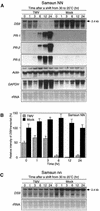
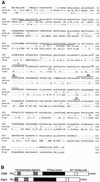
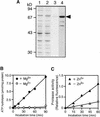
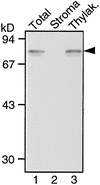
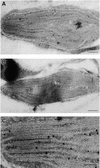

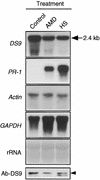


Similar articles
-
Influence of host chloroplast proteins on Tobacco mosaic virus accumulation and intercellular movement.Plant Physiol. 2013 Jan;161(1):134-47. doi: 10.1104/pp.112.207860. Epub 2012 Oct 24. Plant Physiol. 2013. PMID: 23096159 Free PMC article.
-
Soluble phospholipase A2 activity is induced before oxylipin accumulation in tobacco mosaic virus-infected tobacco leaves and is contributed by patatin-like enzymes.Plant J. 2000 Aug;23(4):431-40. doi: 10.1046/j.1365-313x.2000.00802.x. Plant J. 2000. PMID: 10972869
-
Over-expression of a scopoletin glucosyltransferase in Nicotiana tabacum leads to precocious lesion formation during the hypersensitive response to tobacco mosaic virus but does not affect virus resistance.Plant Mol Biol. 2004 Jan;54(1):137-46. doi: 10.1023/B:PLAN.0000028775.58537.fe. Plant Mol Biol. 2004. PMID: 15159640
-
Tobacco mosaic virus virulence and avirulence.Philos Trans R Soc Lond B Biol Sci. 1999 Mar 29;354(1383):645-51. doi: 10.1098/rstb.1999.0416. Philos Trans R Soc Lond B Biol Sci. 1999. PMID: 10212944 Free PMC article. Review.
-
Organization and expression of the Nicotiana chloroplast genome.Biotechnology. 1989;12:295-315. doi: 10.1016/b978-0-409-90068-2.50020-4. Biotechnology. 1989. PMID: 2469507 Review. No abstract available.
Cited by
-
Understanding chloroplast biogenesis using second-site suppressors of immutans and var2.Photosynth Res. 2013 Oct;116(2-3):437-53. doi: 10.1007/s11120-013-9855-9. Epub 2013 May 24. Photosynth Res. 2013. PMID: 23703455 Review.
-
A hypersensitive response-induced ATPase associated with various cellular activities (AAA) protein from tobacco plants.Plant Mol Biol. 2004 Dec;56(6):973-85. doi: 10.1007/s11103-004-6459-y. Epub 2005 Apr 7. Plant Mol Biol. 2004. PMID: 15821994
-
A diterpene as an endogenous signal for the activation of defense responses to infection with tobacco mosaic virus and wounding in tobacco.Plant Cell. 2003 Apr;15(4):863-73. Plant Cell. 2003. PMID: 12671083 Free PMC article.
-
The Arabidopsis gene SIGMA FACTOR-BINDING PROTEIN 1 plays a role in the salicylate- and jasmonate-mediated defence responses.Plant Cell Environ. 2010 May;33(5):828-39. doi: 10.1111/j.1365-3040.2009.02109.x. Epub 2010 Feb 5. Plant Cell Environ. 2010. PMID: 20040062 Free PMC article.
-
Temporal gene expression profiling of the wheat leaf rust pathosystem using cDNA microarray reveals differences in compatible and incompatible defence pathways.Int J Plant Genomics. 2007;2007:17542. doi: 10.1155/2007/17542. Int J Plant Genomics. 2007. PMID: 18288238 Free PMC article.
References
-
- Adam, Z. (1996). Protein stability and degradation in chloroplasts. Plant Mol. Biol. 32, 773–783. - PubMed
-
- Akiyama, Y., Shirai, Y., and Ito, K. (1994). Involvement of FtsH in protein assembly into and through the membrane. II. Dominant mutations affecting FtsH functions. J. Biol. Chem. 269, 5225–5229. - PubMed
-
- Akiyama, Y., Kihara, A., and Ito, K. (1996. a). Subunit a of proton ATPase F0 sector is a substrate of the FtsH protease in Escherichia coli. FEBS Lett. 399, 26–28. - PubMed
-
- Akiyama, Y., Kihara, A., Tokuda, H., and Ito, K. (1996. b). FtsH (HflB) is an ATP-dependent protease selectively acting on SecY and some other membrane proteins. J. Biol. Chem. 271, 31196–31201. - PubMed
Publication types
MeSH terms
Substances
Associated data
- Actions
LinkOut - more resources
Full Text Sources

